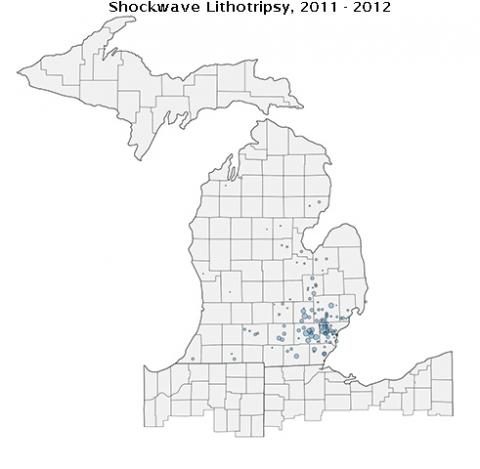About SWL
The most commonly performed surgery for kidney stones is shockwave lithotripsy. With this procedure, stones in the kidney and ureter are pulverized into small fragments by means of short-duration, high-energy shockwaves that are produced outside the body by a lithotripter. At the University of Michigan, shockwave lithotripsy is performed at the Livonia Center for Specialty Care as an out-patient procedure (you go home the same day).
While over 90% of kidney stones can be treated with shockwave lithotripsy, there are certain circumstances when it is not recommended such as a urinary tract infection, ureteral obstruction near the stone, in patients on anticoagulation medications or those with bleeding disorders, patient anatomy that makes it difficult to target the stone, and pregnancy.
What you should anticipate:
Pre-Op
- Lab tests and X-rays will be obtained to ensure your safety during the procedure.
- You may receive an antibiotic, either by mouth or through an IV, right before the procedure.
- The anesthesia team will attach monitoring devices to you.
- Generally speaking, your procedure can be done with just intravenous sedation; however, in a small number of cases general anesthesia is required.
- Most of the time, you will lie on your back for the procedure.
- Depending on your stone’s location, you may be placed on your abdomen on the operating room table.
- The focus of the lithotripter is positioned on the stone using X-ray or ultrasound imaging.
- The shockwave generator is then pressed against your side.
- A cold gel-like material is applied in between the shockwave generator and your skin.
During procedure
- Your procedure will take 30 to 60 minutes to complete.
- Treatment time is dependent on your stone’s size and hardness.
- Progress is assessed in real time with X-ray and/or ultrasound imaging.
- It is important for you to remain still during treatment to keep your stone in focus.
- After the procedure, there is a short observation period.
- You are able to return home after this brief period.
Post-Op
- You may experience blood in your urine after treatment.
- This typically clears up after 1 to 3 days.
- Notify the urology team if it lasts longer than 3 days.
- To help pass stone fragments, you are encouraged to drink plenty of water.
- While the stone fragments pass, you may experience pain in the flank area, as well as nausea
- If these symptoms persist, if you develop intolerance of food and water, or if you develop fevers greater than 101.5, you should contact the Urology team immediately.
- You may be directed to go to the Emergency Department.
- You may also have pink urine while passing these fragments
- You may be given a medicine (i.e. Flomax [tamsulosin]) to take at home to relax the ureter and facilitate stone passage.
- Most people can typically resume normal activities within 1 to 3 days of surgery.
- You will have a follow up visit with the urology team approximately 4 weeks after surgery. At that time, an X-ray will be taken to determine the procedure’s success.
- Depending on your risk of recurrence, you may be offered further testing to help prevent future stones.

In this map, the size of each point is proportional to the number of patients referred to the University of Michigan from that zip code area.
